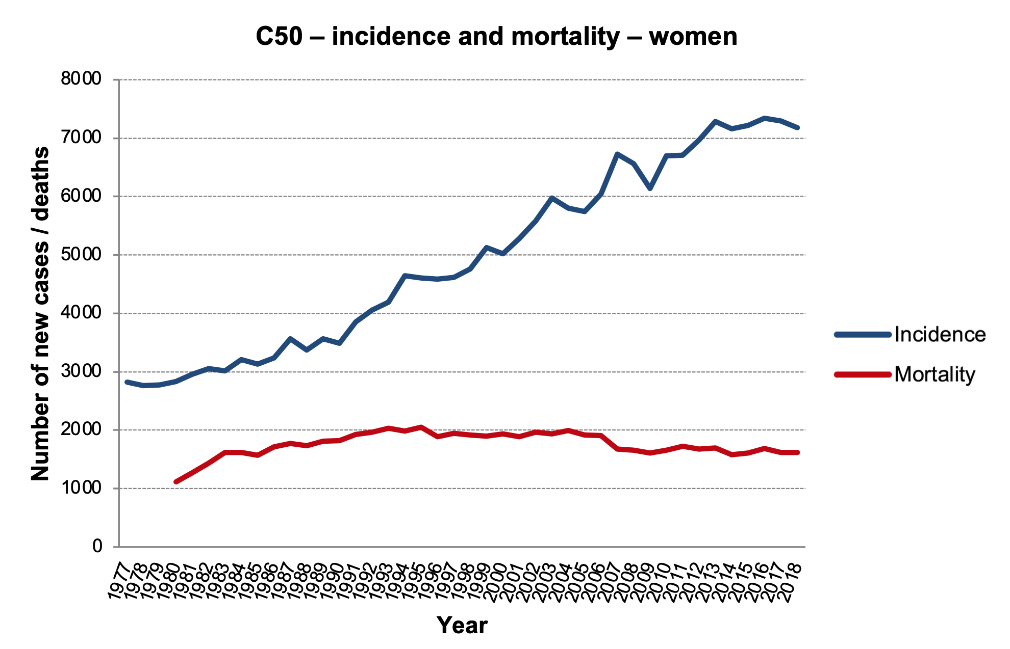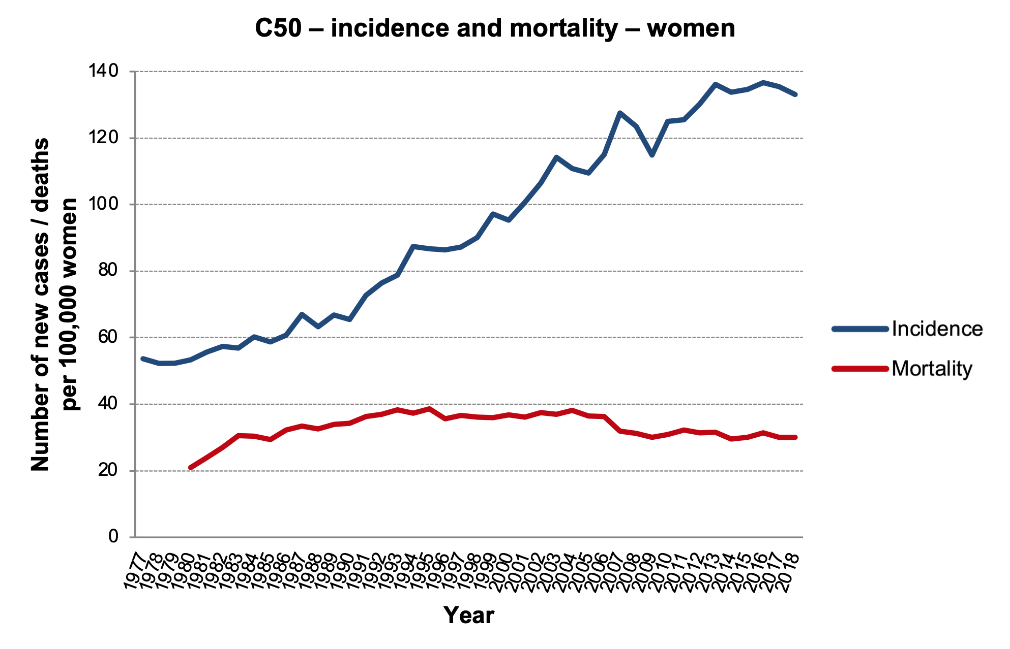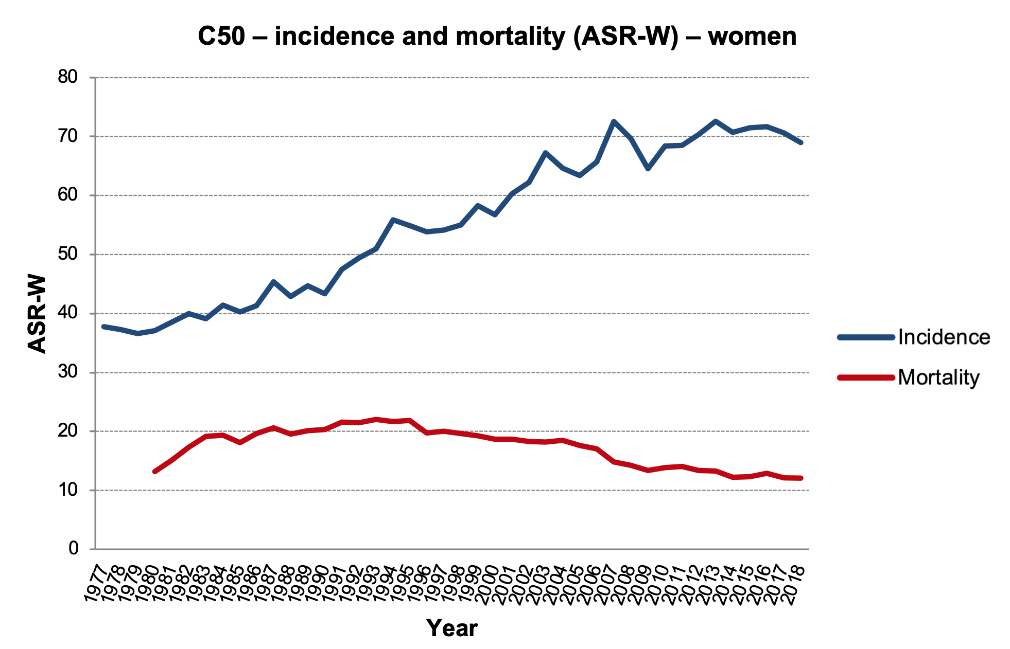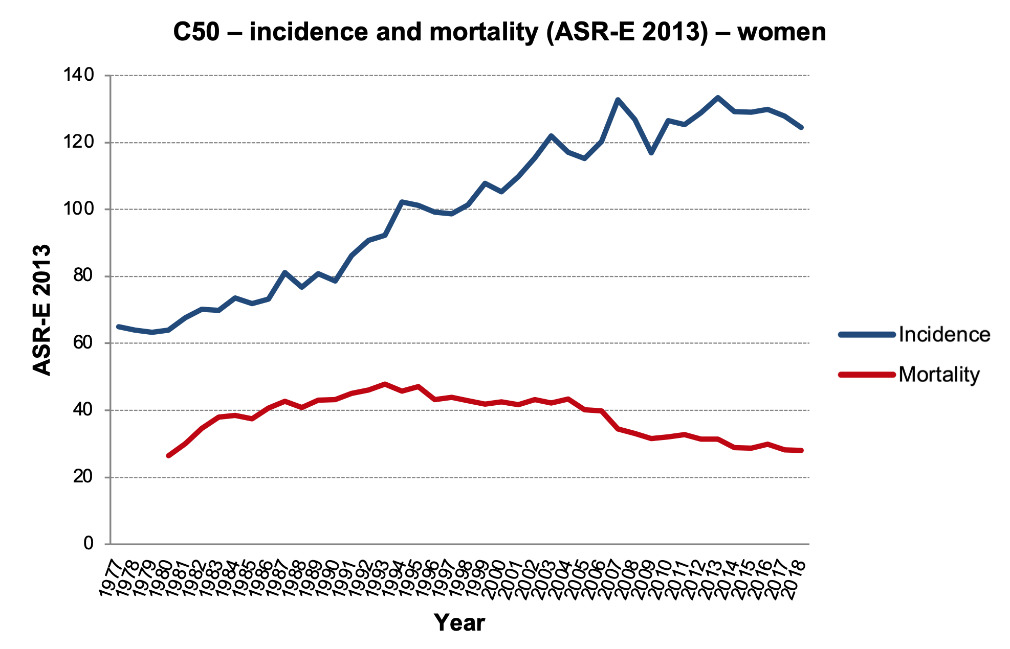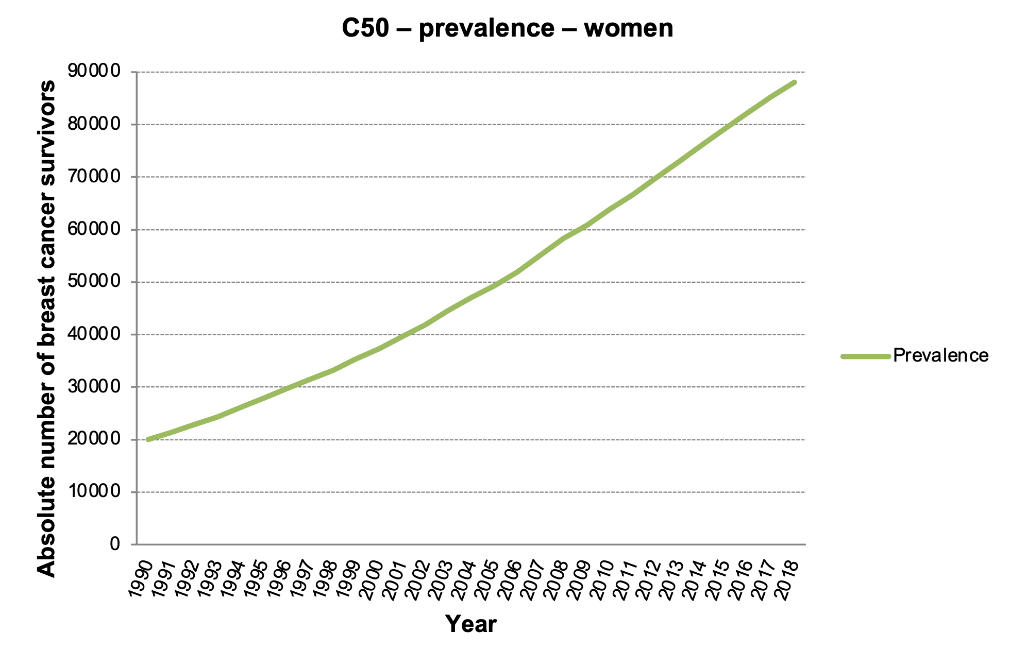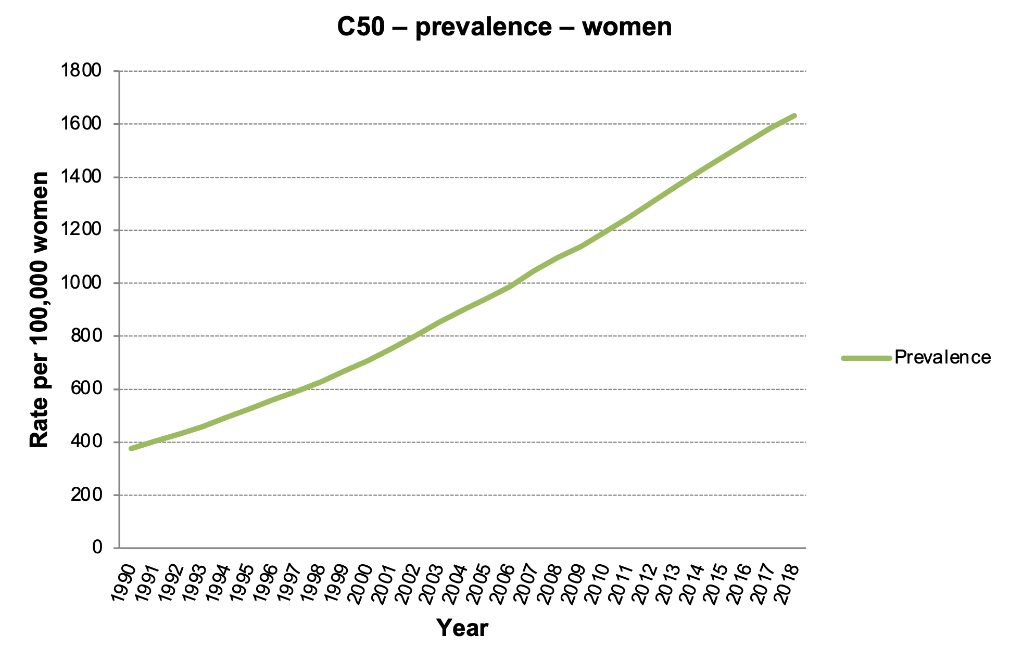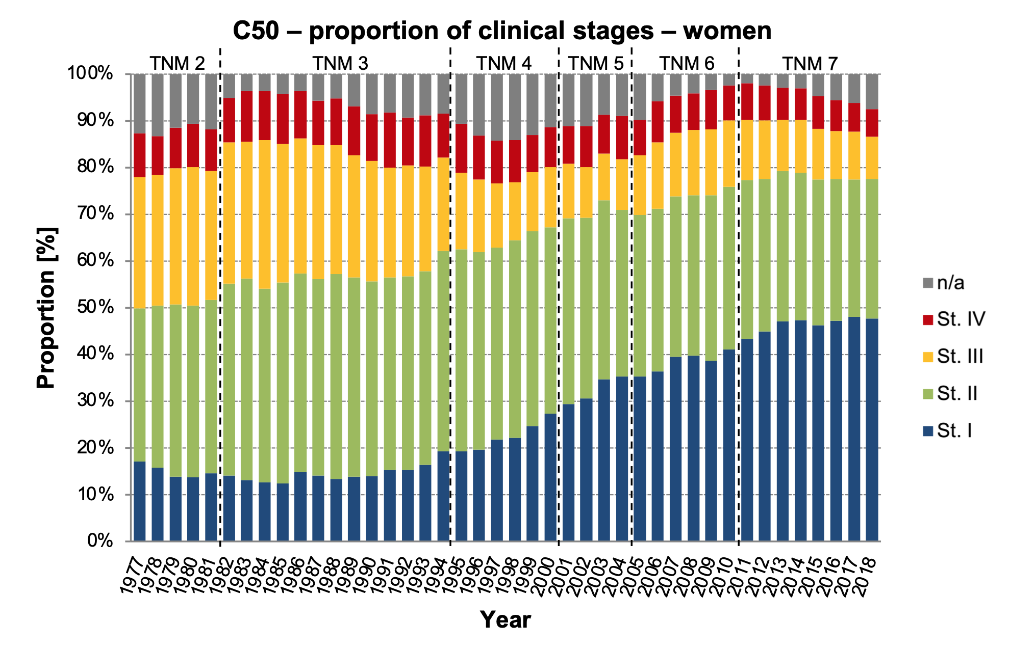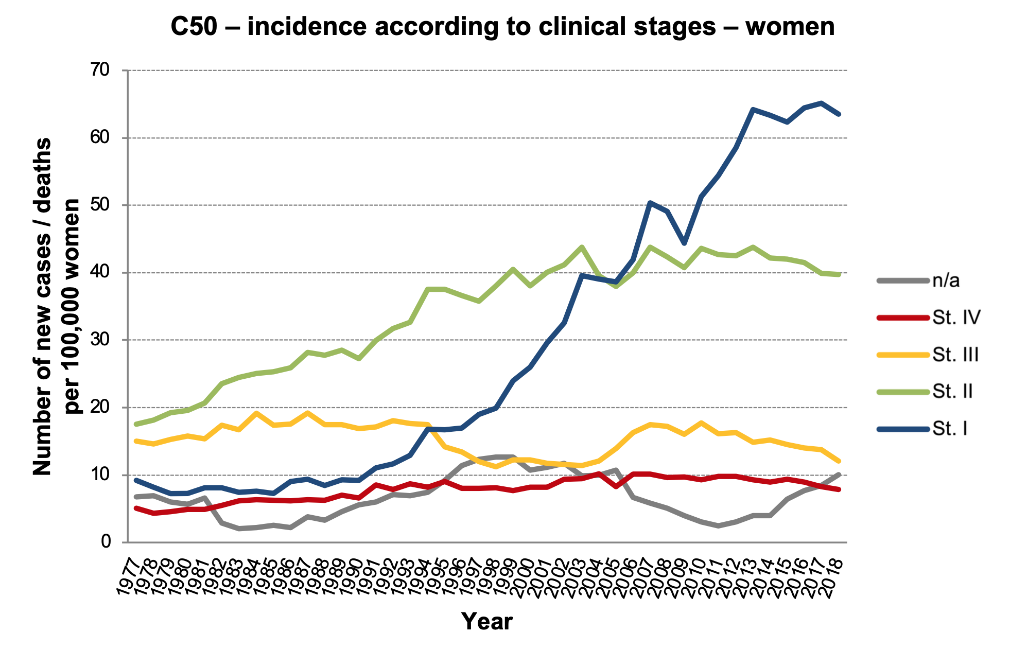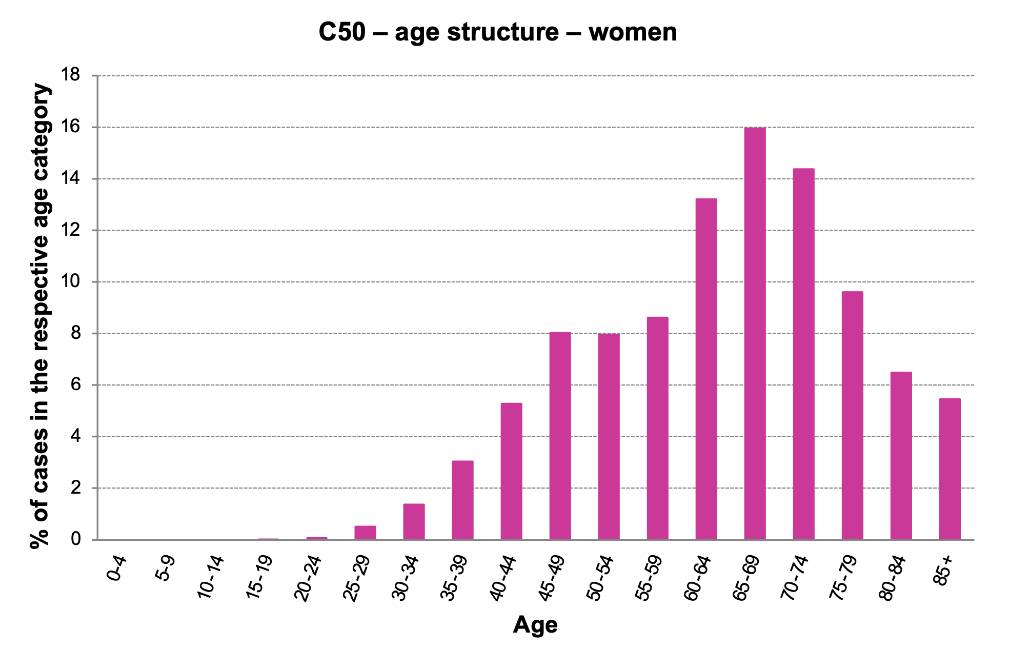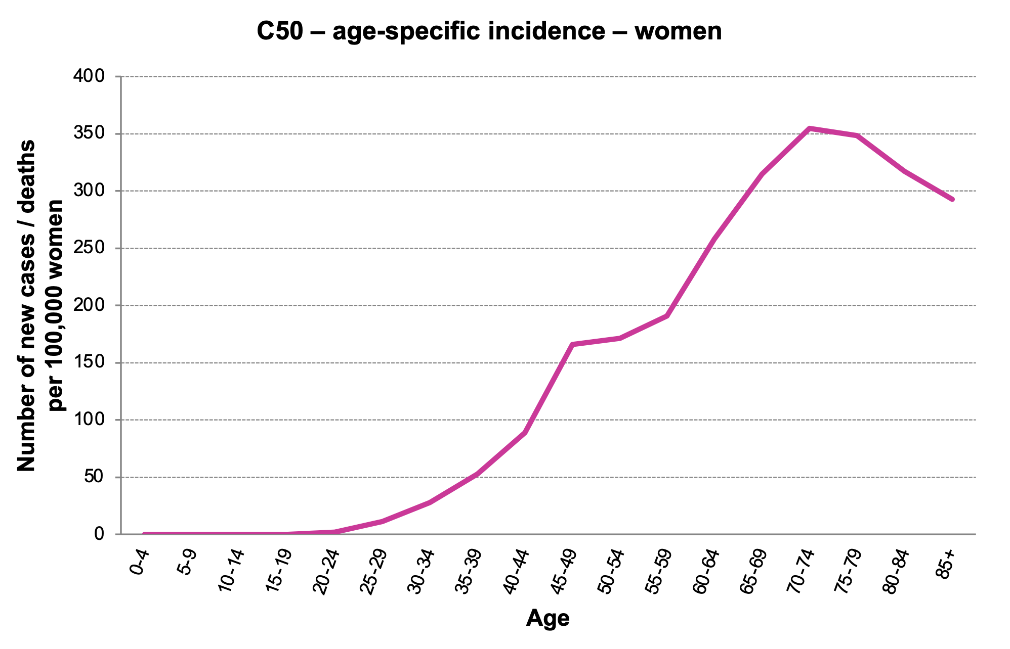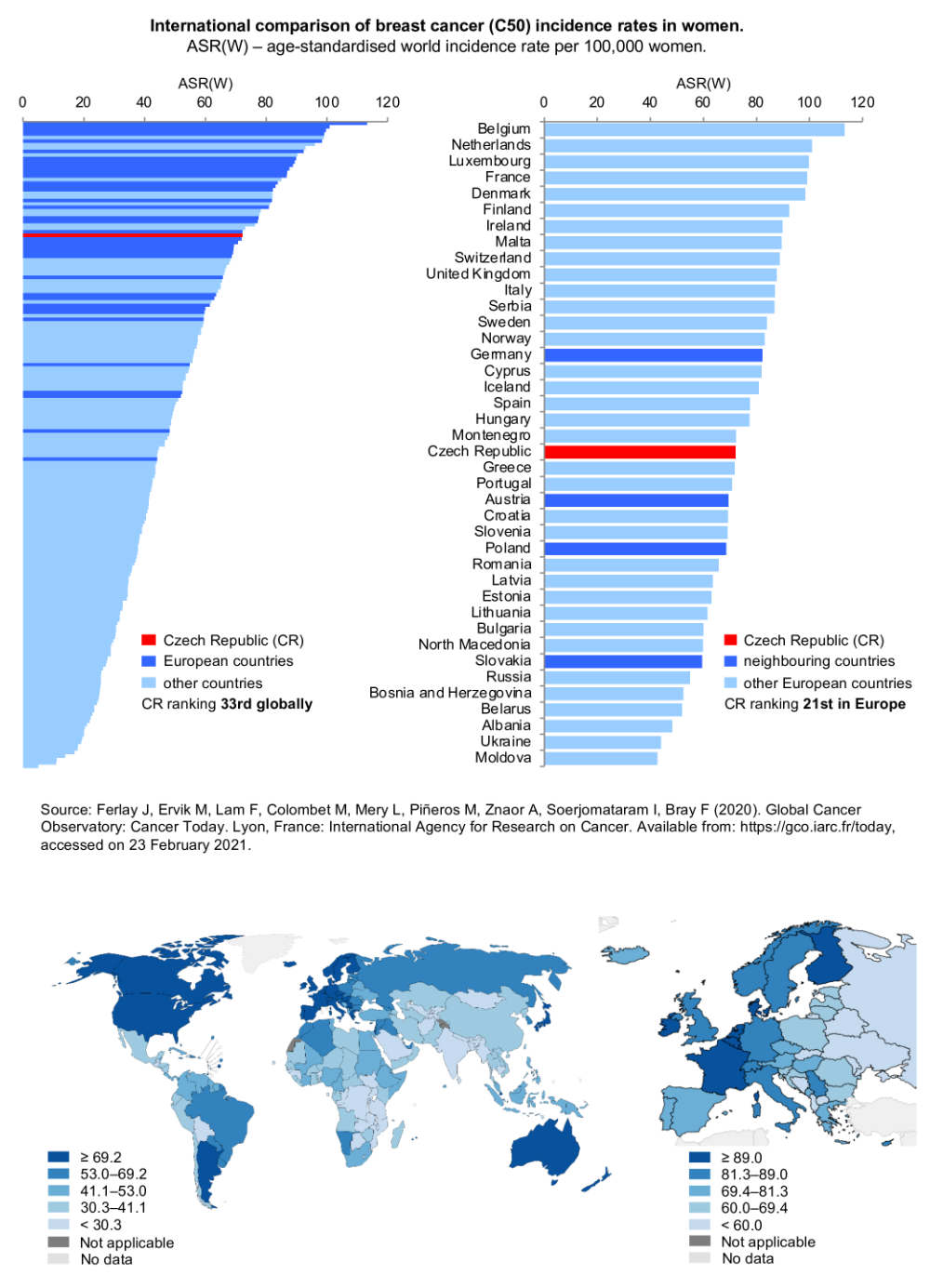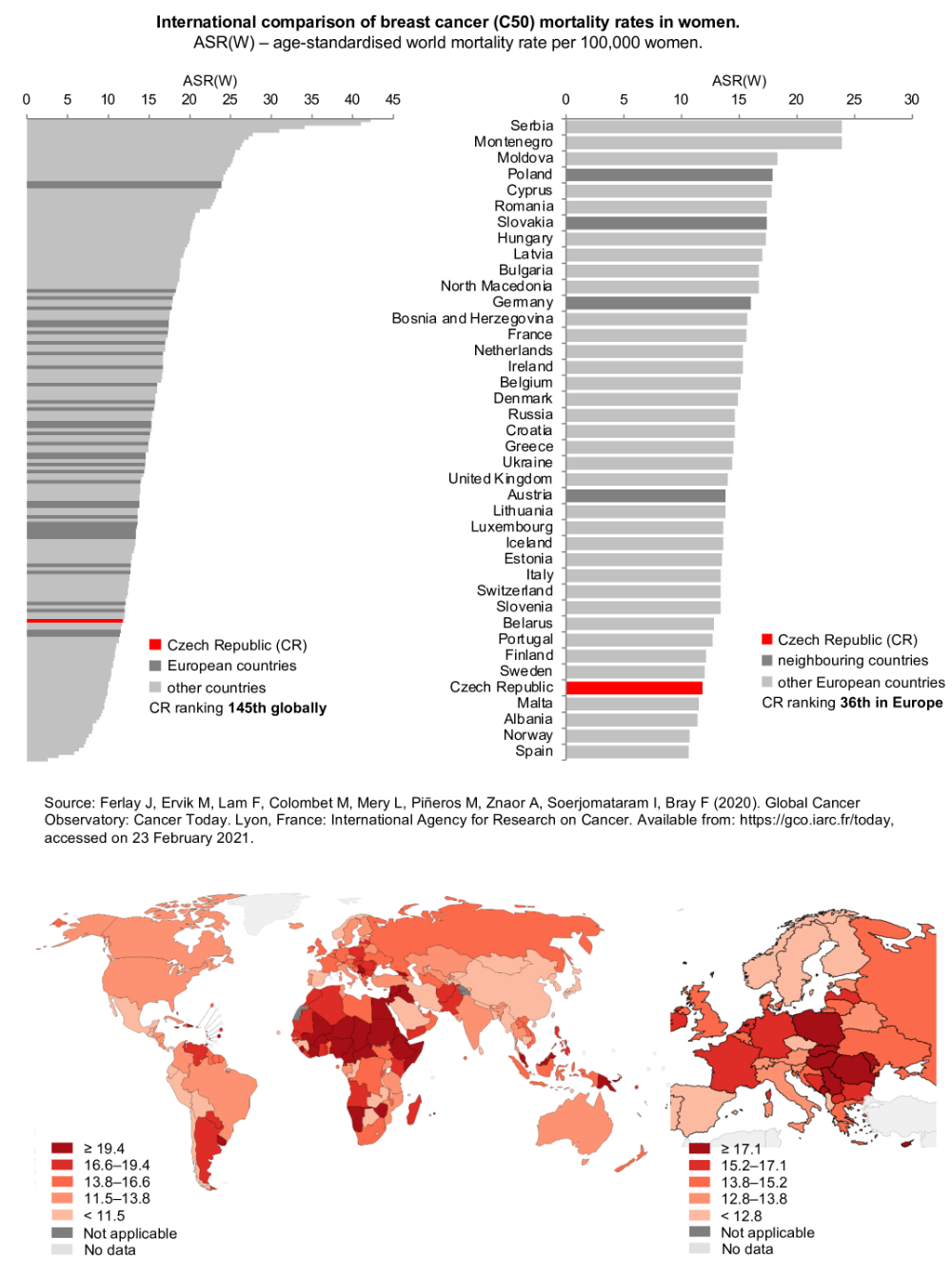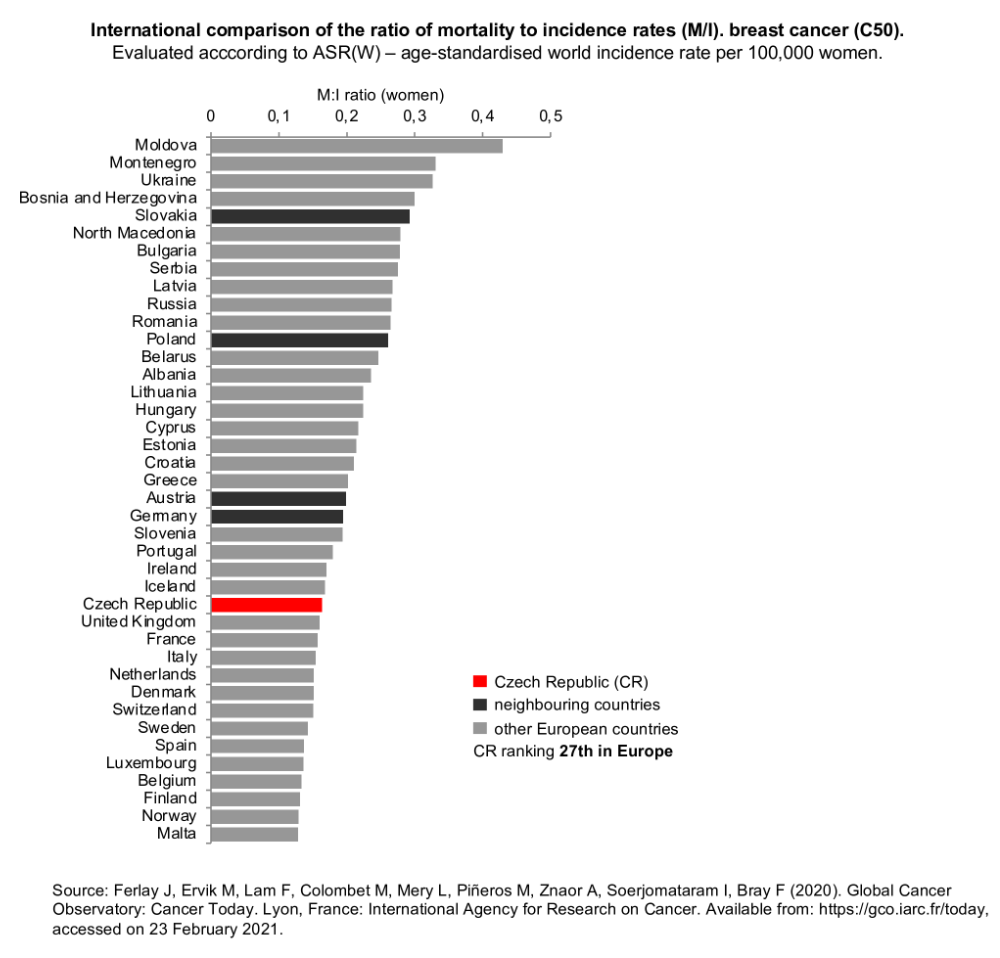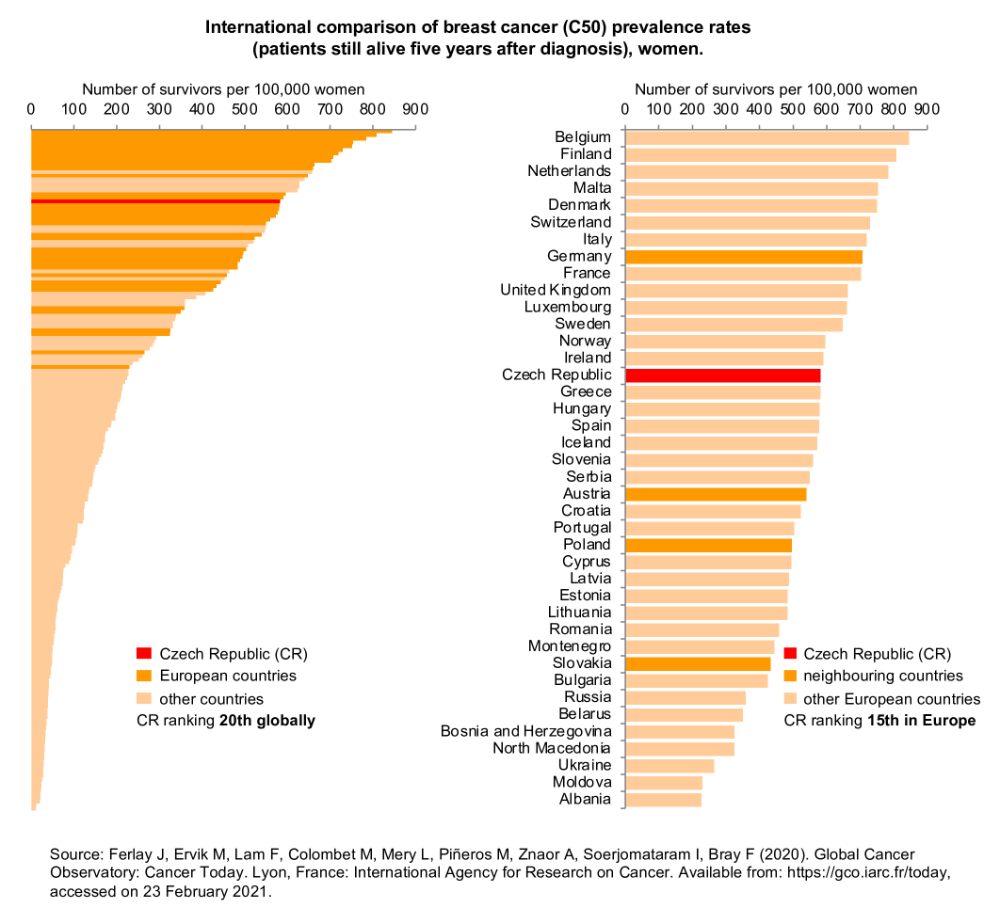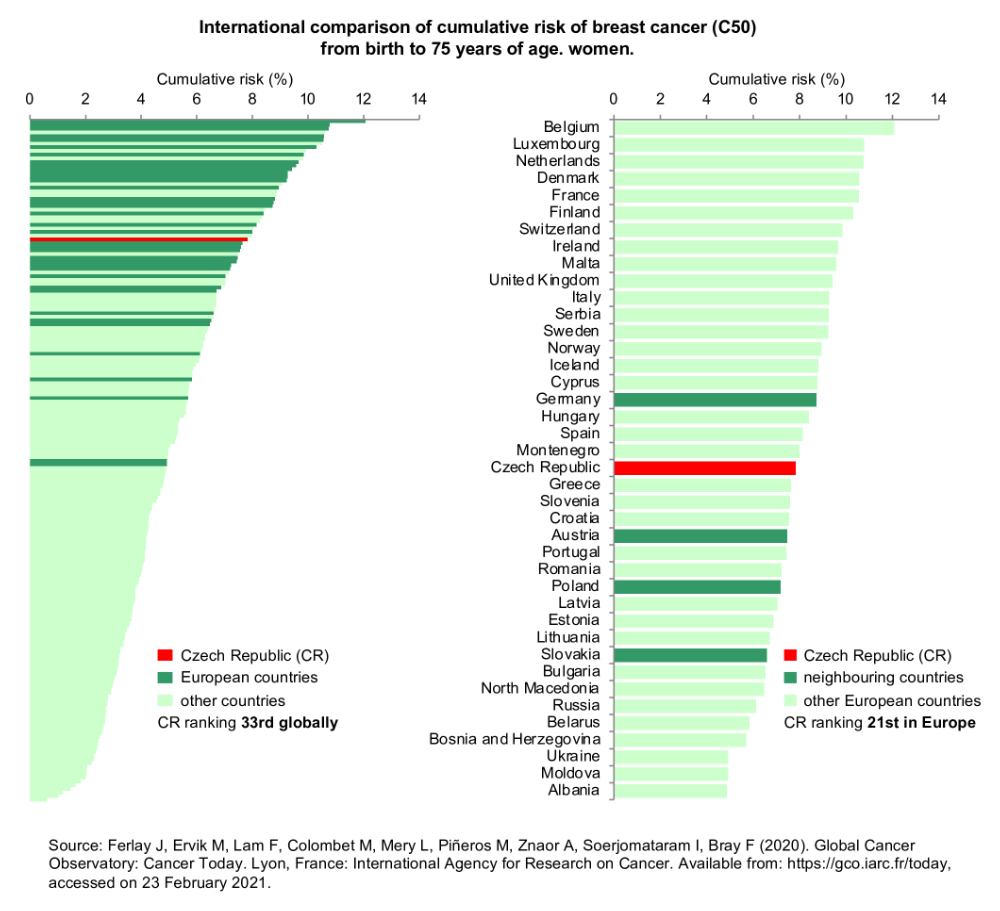Breast cancer epidemiology
Czech Republic
The Czech National Cancer Registry (CNCR) is the main source of data on cancer epidemiology in the Czech Republic. CNCR has become an integral part of comprehensive cancer care, containing more than 2.6 million records from the period 1977–2018 and covering 100% of the Czech population. Registration of malignant tumours is stipulated by law and is obligatory [1]. CNCR data is publicly available on the website www.svod.cz [2].
-
Breast cancer incidence and mortality in women
Among all cancers excluding non-melanoma skin cancer (C00–C97 excluding C44), breast cancer is the most common cancer in women. Each year, approximately 7,200 women are diagnosed with breast cancer in the Czech Republic, and there are approximately 1,600 deaths from breast cancer among Czech women. The epidemiological trends for breast cancer are characterised by a continuously increasing incidence, although the rise has slowed and there has even been an indication of stabilisation in recent years. As for mortality rates, these have shown a stagnation, and even a slight decrease since the 1990s (Fig. 1a). In 2018, there were 7,182 new cases of breast cancer in women, corresponding to more than 133 cancers per 100,000 women in the Czech population. In the same year, there were 1,621 breast cancer deaths among women in the Czech Republic, corresponding to 30 breast cancer deaths per 100,000 women in the Czech population.
Apart from absolute numbers of newly diagnosed cases and deaths per year (Fig. 1a), breast cancer incidence and mortality rates can be recalculated per 100,000 women in the population (Fig. 1b) or standardized on a certain age standard; the most common ones include the age-standardized world rate (ASR-W, Fig. 1c) and the new age-standardized European rate (ASR-E 2013, Fig. 1d). Such recalculations make it possible to compare breast incidence and mortality rates with those of other countries (see more details in Epidemiology of breast cancer: international comparison).
Figure 1a: Absolute numbers of new cases / deaths. Data source: CNCR (incidence in the entire period, mortality up to 1993), CZSO (mortality since 1994)
Figure 1c: Age-standardised world rates (ASR-W). Data source: CNCR (incidence in the entire period, mortality up to 1993), CZSO (mortality since 1994)
-
Breast cancer prevalence in women
Since the 1990s, the epidemiological situation has gradually improved: namely, mortality rates have stabilized and even slightly decreased (see above). Continuously growing incidence rates, however, have inevitably led to an increase in prevalence rates, i.e. the number of breast cancer survivors. In 2018, the prevalence of women with a history of breast cancer reached 88,059, corresponding to a 51.1% increase in comparison with 2008 (58,296 breast cancer survivors) (Fig. 2a).
Prevalence can be also expressed as a rate per 100,000 women in the population (Fig. 2b), allowing the comparison with other countries (see Fig. 4 in Epidemiology of breast cancer: international comparison).
-
Clinical stages
It is widely known that a cancer diagnosed at an early stage (or even at the stage of precancerous changes) is much more likely to be treated successfully and that the chance of survival in such cases is much higher. Available population-based data on breast cancer epidemiology in the Czech Republic show a steadily growing increase in the proportion of early stages among newly diagnosed cases of breast cancer (Fig 3a). This is a very positive trend, as the 5-year survival of breast cancer patients who were diagnosed at stage I (or even with an in situ carcinoma) is almost 100%. Fig. 3b shows trends in breast cancer incidence rates when taking into account the stage at which the disease is diagnosed.
-
Age structure of patients
Breast cancer markedly affects women in working age. The typical age of Czech breast cancer patients is between 60 and 74 years, but approximately 35% of all patients are under the age of 60 (Fig. 4a). Fig. 4b shows the profile of age-specific incidence rates for breast cancer.
-
References
- Institute of Health Information and Statistics of the Czech Republic: Czech National Cancer Registry (CNCR) [20 January 2021]. http://www.uzis.cz/registry-nzis/nor
- Dušek, L., Mužík, J., Kubásek, M., Koptíková, J., Žaloudík, J., Vyzula, R.: Epidemiology of malignant tumours in the Czech Republic [online]. Masaryk University, Brno (Czech Republic), 2005. Available from WWW: http://www.svod.cz. ISSN 1802-8861.
International comparison
Breast cancer is among the most commonly diagnosed cancers in women worldwide. In 2020, according to the GLOBOCAN estimates [1], there were 2,261,419 new cases of breast cancer worldwide (the most common cancer in women worldwide, accounting for 25.8% of all cancers in women apart from non-melanoma skin cancers), and 531,086 new cases of breast cancer in Europe (the most common cancer in women in Europe, accounting for 27.8% of all cancers in women apart from non-melanoma skin cancers). In 2020, there were an estimated 684,996 deaths from breast cancer worldwide (15.6% of the total number of cancer deaths in women, the most common cause of cancer-related deaths in women), and 141,765 deaths from breast cancer in Europe (16.4% of the total number of cancer deaths in women, the most common cause of cancer-related deaths in women). The 5-year prevalence of breast cancer (i.e., the number of breast cancer patients who were still alive five years after diagnosis) in 2020 was estimated at 7,790,717 worldwide (201.6 breast cancer survivors per 100,000 women) and 2,138,117 in Europe (552.2 breast cancer survivors per 100,000 women). In 2020, the cumulative risk of breast cancer in women aged under 75 was 5.20% worldwide and 8.01% in Europe [1].
-
Basic overview of epidemiological characteristics
Tables 1 and 2 provide a basic overview of epidemiological characteristics of breast cancer worldwide and in Europe. This data demonstrates a significant breast cancer burden in European countries, which is still associated with very high mortality rates. High breast cancer incidence and mortality rates are also shown in Figures 1 and 2.
Table 1: Epidemiology of breast cancer worldwide. Source: GLOBOCAN 2020.
Parameter Women Incidence rates
number of new cases
2,261,419
number of new cases per 100,000 women
58.5
ASR(W)
47.8
proportion of all newly diagnosed cancers (apart from skin cancers)
25.8%
rank among all newly diagnosed cancers (apart from skin cancers)
1st
Mortality rates
number of deaths
684,996
number of deaths per 100,000 women
17.7
ASR(W)
13.6
proportion of all cancer-related deaths (apart from skin cancers)
15.6%
rank among all cancer-related deaths (apart from skin cancers)
1st
Prevalence rates (patients still alive five years after diagnosis)
absolute number of survivors
7,790,717
rate per 100,000 women
201.6
Cumulative risk of developing breast cancer
from birth until the age of 75
5.20%
Table 2: Epidemiology of breast cancer in Europe. Source: GLOBOCAN 2020.
Parameter Women Incidence rates
number of new cases
531,086
number of new cases per 100,000 women
137.2
ASR(W)
74.3
proportion of all newly diagnosed cancers (apart from skin cancers)
27.8%
rank among all newly diagnosed cancers (apart from skin cancers)
1st
Mortality rates
number of deaths
141,765
number of deaths per 100,000 women
36.6
ASR(W)
14.8
proportion of all cancer-related deaths (apart from skin cancers)
16.4%
rank among all cancer-related deaths (apart from skin cancers)
1st
Prevalence rates (patients still alive five years after diagnosis)
absolute number of survivors
2,138,117
rate per 100,000 women
552.2
Cumulative risk of developing breast cancer
from birth until the age of 75
8.01%
-
Incidence and mortality
High breast cancer incidence and mortality rates are also shown in Figures 1 and 2. Czech female breast cancer incidence rates rank 33rd worldwide and 21st in Europe, while Czech female breast cancer mortality rates rank 145th worldwide and 36th in Europe.
Figure 1: International comparison of breast cancer (C50) incidence rates in women. ASR(W) – age-standardised world incidence rate per 100,000 women. (Source: GLOBOCAN 2020)
-
Prevalence and M/I ratio
International epidemiological statistics make it possible to estimate the ratio of mortality to incidence rates (M/I), which can be considered as an indirect indicator of survival of breast cancer patients in a given country (Figure 3). According to the most recent statistics, the Czech Republic with its M/I ratio at 0.16 has already caught up with the developed Western European countries, for which the M/I ratio ranges from 0.12 to 0.20. Recent data from the Czech National Cancer Registry [2], i.e. the incidence of 68.99 and the mortality of 12.80 (data from 2018 recalculated as ASR-W), give the ratio of 0.19. Internationally assessed prevalence rates (i.e., number of patients still alive five years after diagnosis) are shown in Figure 4. As a logical consequence, the highest prevalence rates have been reported for countries with the lowest values of M/I ratio. As for breast cancer prevalence rates, the Czech Republic is above average among European countries.
Figure 3: International comparison of the ratio of mortality to incidence rates (M/I), breast cancer (C50). Evaluated acccording to ASR(W) – age-standardised world incidence rate per 100,000 women. (Source: GLOBOCAN 2020)
-
Cumulative risk
Let us conclude this overview of international statistics with a summary of cumulative risk of breast cancer in women from birth until the age of 75 (Figure 5). High values of this risk reflect a high population burden with this disease, which is typical for European countries in particular. Cumulative risk for the Czech Republic is 7.82, so the Czech female population occupies an average position in Europe (21st) and above-average globally (33rd).
-
References
- 1. Ferlay J, Ervik M, Lam F, Colombet M, Mery L, Piñeros M, Znaor A, Soerjomataram I, Bray F (2020). Global Cancer Observatory: Cancer Today. Lyon, France: International Agency for Research on Cancer [accessed on 1 March 2021]. Available from WWW: https://gco.iarc.fr/today.
- Dušek L., Mužík J., Kubásek M., Koptíková J., Žaloudík J., Vyzula R. Epidemiology of malignant tumours in the Czech Republic [online]. Masaryk University, Brno (Czech Republic) [2005], [accessed on 1 March 2021]. Available from WWW: http://www.svod.cz. Version 7.0 [2007], ISSN 1802-8861.
